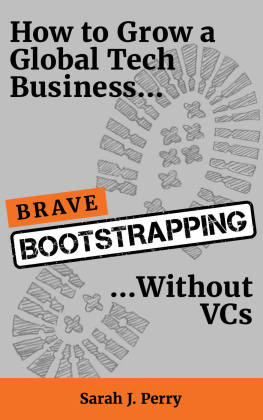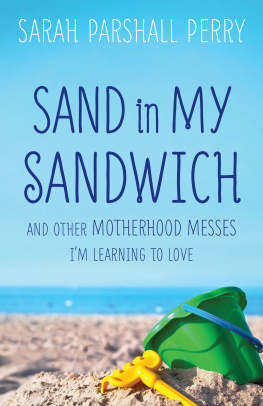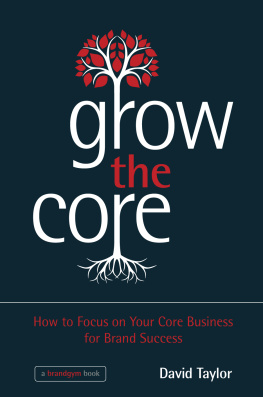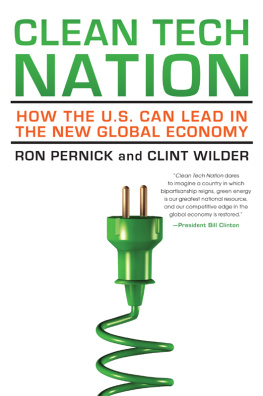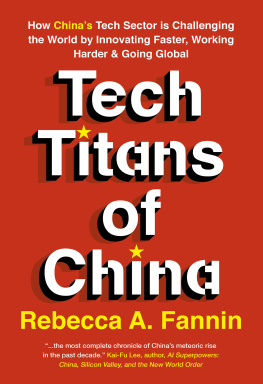Sarah J Perry - Brave Bootstrapping: How to Grow a Global Tech Business Without VCs
Here you can read online Sarah J Perry - Brave Bootstrapping: How to Grow a Global Tech Business Without VCs full text of the book (entire story) in english for free. Download pdf and epub, get meaning, cover and reviews about this ebook. year: 2018, publisher: Brave Minx Publishing, genre: Business. Description of the work, (preface) as well as reviews are available. Best literature library LitArk.com created for fans of good reading and offers a wide selection of genres:
Romance novel
Science fiction
Adventure
Detective
Science
History
Home and family
Prose
Art
Politics
Computer
Non-fiction
Religion
Business
Children
Humor
Choose a favorite category and find really read worthwhile books. Enjoy immersion in the world of imagination, feel the emotions of the characters or learn something new for yourself, make an fascinating discovery.
- Book:Brave Bootstrapping: How to Grow a Global Tech Business Without VCs
- Author:
- Publisher:Brave Minx Publishing
- Genre:
- Year:2018
- Rating:3 / 5
- Favourites:Add to favourites
- Your mark:
- 60
- 1
- 2
- 3
- 4
- 5
Brave Bootstrapping: How to Grow a Global Tech Business Without VCs: summary, description and annotation
We offer to read an annotation, description, summary or preface (depends on what the author of the book "Brave Bootstrapping: How to Grow a Global Tech Business Without VCs" wrote himself). If you haven't found the necessary information about the book — write in the comments, we will try to find it.
Sarah J Perry: author's other books
Who wrote Brave Bootstrapping: How to Grow a Global Tech Business Without VCs? Find out the surname, the name of the author of the book and a list of all author's works by series.
Brave Bootstrapping: How to Grow a Global Tech Business Without VCs — read online for free the complete book (whole text) full work
Below is the text of the book, divided by pages. System saving the place of the last page read, allows you to conveniently read the book "Brave Bootstrapping: How to Grow a Global Tech Business Without VCs" online for free, without having to search again every time where you left off. Put a bookmark, and you can go to the page where you finished reading at any time.
Font size:
Interval:
Bookmark:
Bootstrapping
How to grow a global technology business without VC funding
SARAH J PERRY
Bootstrapping a business while raising a family requires some sacrifices. I am taking this opportunity to express my most profound love for, and appreciation of, my children Danielle and Alex. For the times I was at my desk, or in my own head, instead of being present with you I am sorry. I think it was worth it and I hope you do too. I am so proud of you both.
To friends and family who listened and supported me over the years, I sincerely thank you too. Particular thanks to Chris and Zivanayour support, patience, and love, even at times when I have been less lovable, are very much appreciated.
I am a co-founder of SnapComms, an enterprise messaging software company. We bootstrapped SnapComms to 1.5 million paid users in 75 countries and growing (at time of writing).
Distorted perceptions
I wrote this book because I think theres a perception problem that needs to be addressed. Businesses are not considered good unless they have the credibility of VC dollars and are growing at 10x+. I believe it creates the wrong pressure. People are starting businesses with a 3- to 5-year exit strategy on day one. The focus is on growth, scale, and making investors wealthy. Often the cost is a negative impact on people (founders, employees, and customers) and values.
Bootstrapped businesses offer sustainable growth
Growing at a slower but more sustainable rate by providing value that customers are willing to pay for from day one is considered safe and boring. Safe? Maybe. Boring? Absolutely not. I think it is an infinitely more enjoyable and sustainable ride for founders and employees.
Is this really innovation?
I find it interesting that innovative startup companies seem to:
- Have an idea (or borrow it)
- Get seed investment
- Grow beards and buy office bean bags and a Ping-Pong table
- Series A Investment
- Series B+ Investment
- Sell out and make a pot of money
Few make it to the final stage, but lots want to be part of the cool club.
Well-funded Unicorns disrupting business models are not here
Well-funded Unicorns disrupting business models is not what this book is about. Those founders are welcome to their highly diluted, uber fast growth. The pressure to deliver an extreme growth target against an inflated valuation is no fun at all in my mind. Many VC-backed entrepreneurs find themselves diluted to very little and sometimes even sacked from the companies they founded. Bootstrapping offers a slower, more rewarding, and agile growth approach with little dilution.
Its OK to be different
When you bootstrap its OK to be different (old, female, a minority, working part-time, managing a disability, whatever your flavor). No one really cares. You have no investors to impress and few or no PR interviews to hold, so you can be yourself and focus on creating a great product, engaged staff, and satisfied customers.
Bootstrapping is more common than you might think
According to Inc Magazine (September 2017 edition), 70% of the Inc 500 fastest-growing companies used their own personal savings as start-up capital. Seventy-four percent said their growth was funded all internally or mostly internally.
Product-market fit and happy customers
I believe founders need to spend more time finding productmarket fit and making customers happy. Asking customers to pay for your product is a fantastic litmus test. Its evidence that you are on to something, or not. Chasing VC dollars can mask poor product-market fit and potentially be a disastrous distraction when founders could be spending their time focusing on meeting customer and market needs with their offering.
Some business models need VC dollars
Not all business models lend themselves to bootstrapping. Regardless, I hope that you will find some inspiration and useful insights in this book. Perhaps this book will help you delay funding and/ or make VC dollars go further. This will mean less dilution and hopefully a better level of later investment on better terms (because your business has proven itself).
Lessons from the trenches
Throughout this book, I will share the experiences we gained by bootstrapping SnapCommsthe tactics, tools, and systems we used, the books we read, and the best online guides.
You write your own story
Each company and founder is different. This is just our story and our learning. I hope that by sharing this book, you can bypass some potholes and find your journey a little more comfortable and more enjoyable. Take what you want and leave the rest or revisit it later as your business grows.
You are in good company
Above all, know that as a bootstrapper you are not alone. Despite what you regularly read in the press, there are many more successful bootstrapped companies than there are Unicorns. VC-funded companies represent less than 1% of businesses, and a large percentage of these funded companies fail.

There are various options for funding a startup, depending on the type of business, founder preferences, and which stage of growth a business is at. For completeness, lets take a quick look at the different kinds of funding available.
Pre-seed and seed funding
Pre-seed funding is usually for amounts of less than $100k, whereas seed funding is typically in the range of $100k to $1.5m. Sources of funding at this stage are sometimes called friends, family, and fools. This is self-explanatory. Angel investors also fit in at this stage. Angels are usually high net worth individuals (often cashed-up entrepreneurs) who support the startup community by investing at an early stage.
Crowdfunding
There several crowdfunding sites that allow you to raise money from the public, either by pre-selling products, providing incentives for investors, and/or merely appealing for donations. Crowdfunding is typically not suitable for B2B offerings. Even the B2C startups tend to find it can require a significant investment of time to do crowdfunding well. There is no such thing as easy money.
VC funding
VC funding can happen at any stage in the life of a business. Names given to the different funding stages are usually based on the amount and timing of the funds as follows:
Series A & B = typically $500k to $5m investment
Series C+ = typically >$5m investment
IPO
An initial public offering (IPO) is when a company is listed on the open share trading market and raises money by issuing and selling shares to the public.
Bootstrapping
A bootstrapped business is a business that doesnt sell shares to investors and instead finds other ways to fund the growth of the company. Some of these are:
- Founder savings
- Founder credit cards
- Government grants
- Entering competitions and winning prizes
- Redundancy payouts
- Bank loans (possibly for a home renovation that doesnt happen)
- And most importantly, customer funds:
- Charging for the development of the initial product and/or services
- Pre-selling products or services
Bootstrapping is sometimes known as organically grown, self-funded, or customer-funded.
Bootstrapped businesses need to run with lean operations and get good fast. They need to acquire paying customers quickly to stay in business and grow.
In the early stages of bootstrapping (until customer revenues can support the founders) the founders may have side gigs such as contracting, selling books or online courses, or selling consulting services. Alternatively, they may work full time or part time and start up the business in their spare time.
Font size:
Interval:
Bookmark:
Similar books «Brave Bootstrapping: How to Grow a Global Tech Business Without VCs»
Look at similar books to Brave Bootstrapping: How to Grow a Global Tech Business Without VCs. We have selected literature similar in name and meaning in the hope of providing readers with more options to find new, interesting, not yet read works.
Discussion, reviews of the book Brave Bootstrapping: How to Grow a Global Tech Business Without VCs and just readers' own opinions. Leave your comments, write what you think about the work, its meaning or the main characters. Specify what exactly you liked and what you didn't like, and why you think so.

